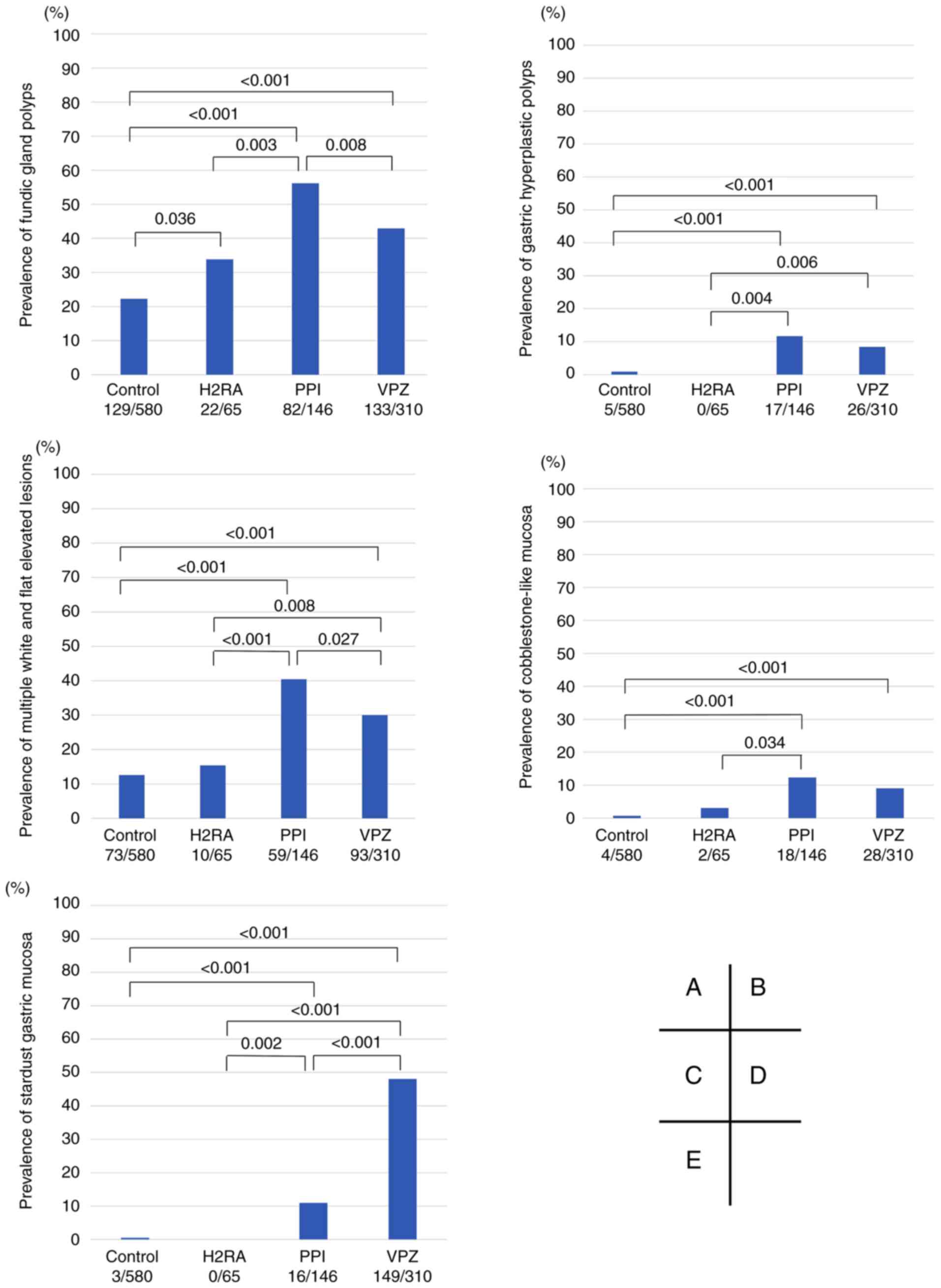
The effect of proton pump inhibitors and vonoprazan on the development of ‘gastric mucosal redness’
- Authors:
- Satoshi Shinozaki
- Hiroyuki Osawa
- Yoshimasa Miura
- Yoshikazu Hayashi
- Hirotsugu Sakamoto
- Tomonori Yano
- Alan Kawarai Lefor
- Hironori Yamamoto
-
View Affiliations
Affiliations: Shinozaki Medical Clinic, Utsunomiya, Tochigi 321‑3223, Japan, Department of Medicine, Division of Gastroenterology, Jichi Medical University, Shimotsuke, Tochigi 329‑0498, Japan, Department of Surgery, Jichi Medical University, Shimotsuke, Tochigi 329‑0498, Japan
- Published online on: May 6, 2022 https://doi.org/10.3892/br.2022.1534
-
Article Number:
51
-
Copyright: © Shinozaki
et al. This
is an open access article distributed under the
terms of Creative
Commons Attribution License.
Metrics:
Total
Views: 0 (Spandidos Publications: | PMC Statistics:
)
Metrics:
Total PDF Downloads: 0 (Spandidos Publications: | PMC Statistics:
)
This article is mentioned in:
Abstract
The safety of long‑term proton pump inhibitor (PPI) and vonoprazan (VPZ) use is a relatively recent concern. Gastric mucosal redness was reported as a VPZ‑associated lesion in a previous study. The aim of this study was to investigate the prevalence and risk factors for gastric mucosal redness. Between December 2020 and November 2021, 1,101 patients who underwent esophagogastroduodenoscopy were reviewed. The cohort was divided into four groups: Control (n=580), histamine‑2 receptor antagonist (H2RA) (n=65), PPI (n=146) and VPZ groups (n=310). Gastric mucosal redness was present in 48/1,101 patients (4%). The prevalence in controls, H2RA, PPI and VPZ groups was 1.9% (11/580), 1.5% (1/65), 6.2% (9/146) and 8.7% (27/310), respectively. Both the PPI and VPZ groups had a significantly higher prevalence of gastric mucosal redness compared with the control group (P<0.001). In the multivariate analysis, PPI and VPZ use were significantly associated with gastric mucosal redness. Fundic gland polyps, gastric hyperplastic polyps, multiple white and flat elevated lesions, cobblestone‑like mucosa, and stardust gastric mucosa were also significantly associated with PPI and VPZ use in the multivariate analysis. Back‑to‑back analysis showed that gastric mucosal redness was not seen before starting PPI/VPZ in most patients. The duration of treatment with VPZ was investigated to determine if it affected the prevalence of gastric mucosal redness. There were no significant differences in treatment duration among patients with and without gastric mucosal redness (mean ± standard deviation: 3.0±1.5 vs. 2.5±1.4 years, P=0.077). In conclusion, the prevalence of gastric mucosal redness was low but was associated with PPI and VPZ use.
View References
|
1
|
Sakurai Y, Mori Y, Okamoto H, Nishimura A,
Komura E, Araki T and Shiramoto M: Acid-inhibitory effects of
vonoprazan 20 mg compared with esomeprazole 20 mg or rabeprazole 10
mg in healthy adult male subjects-a randomised open-label
cross-over study. Aliment Pharmacol Ther. 42:719–730.
2015.PubMed/NCBI View Article : Google Scholar
|
|
2
|
Shinozaki S, Osawa H, Hayashi Y, et al:
Changes in gastric morphology during long-term use of vonoprazan
compared to proton pump inhibitors. Singapor Med J (in press):
Accepted on April 24, 2021.
|
|
3
|
Yoshizaki T, Morisawa T, Fujinami M,
Matsuda T, Katayama N, Inoue K, Matsumoto M, Ikeoka S, Takagi M,
Sako T, et al: Propensity score matching analysis: Incidence and
risk factors for ‘stardust’ gastric mucosa, a novel gastric finding
potentially induced by vonoprazan. Aliment Pharmacol Ther.
53:94–102. 2021.PubMed/NCBI View Article : Google Scholar
|
|
4
|
Kubo K, Kimura N, Matsuda S, Tsuda M, Mabe
K and Kato M: Vonoprazan-associated gastric mucosal redness: A
report of four cases. Intern Med. 59:507–511. 2020.PubMed/NCBI View Article : Google Scholar
|
|
5
|
Kubo K, Kimura N, Watanabe R, Higashino M,
Tsuda M and Kato M: Vonoprazan-associated gastric mucosal redness
in non-Helicobacter pylori-infected and Helicobacter
pylori-eradicated stomach. Case Rep Gastroenterol. 15:751–758.
2021.PubMed/NCBI View Article : Google Scholar
|
|
6
|
Shinozaki S, Osawa H, Hayashi Y, Lefor AK
and Yamamoto H: Linked color imaging for the detection of early
gastrointestinal neoplasms. Therap Adv Gastroenterol.
12(1756284819885246)2019.PubMed/NCBI View Article : Google Scholar
|
|
7
|
Kimura K and Takemoto T: An endoscopic
recognition of the atrophic border and its significance in chronic
gastritis. Endoscopy. 1:87–97. 1969.
|
|
8
|
Hasegawa R, Yao K, Ihara S, Miyaoka M,
Kanemitsu T, Chuman K, Ikezono G, Hirano A, Ueki T, Tanabe H, et
al: Magnified endoscopic findings of multiple white flat lesions: A
new subtype of gastric hyperplastic polyps in the stomach. Clin
Endosc. 51:558–562. 2018.PubMed/NCBI View Article : Google Scholar
|
|
9
|
Miyamoto S, Kato M, Tsuda M, Matsuda K,
Muranaka T, Abiko S, Ono M, Mizushima T, Omori S, Yamamoto K, et
al: Gastric mucosal cracked and cobblestone-like changes resulting
from proton pump inhibitor use. Dig Endosc. 29:307–313.
2017.PubMed/NCBI View Article : Google Scholar
|















